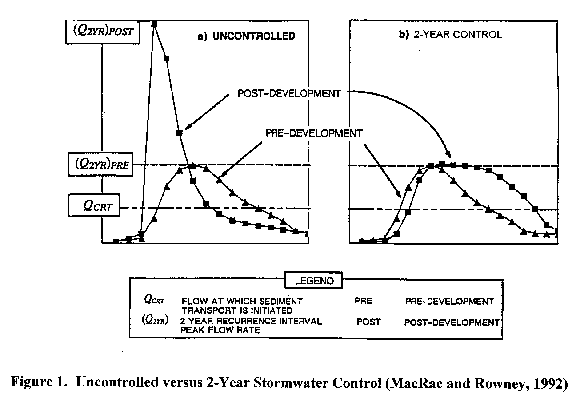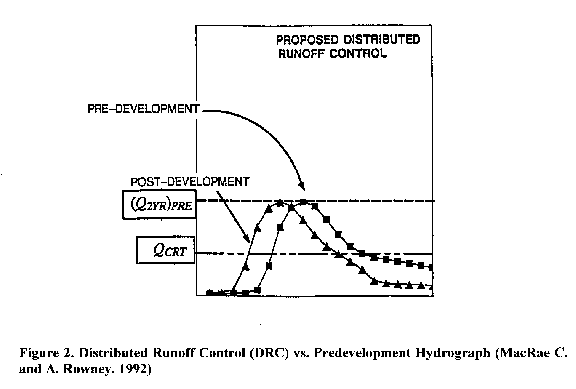As pervious surfaces such as fields and forests are converted to impervious surfaces, both the volume of runoff and the frequency of "channel-forming" events increases substantially. Research suggests that this change in hydrology can cause channels to expand to two to five times their original size (Hammer, 1972, Moriwasa and LaFlure, 1979, Allen and Narramore, 1985 and Booth, 1990).� Channel erosion, on average, is estimated to account for 66% to 75% of the sediment load in urban watersheds (Trimble, 1997 and Dartinguenave et al.,1997).� Furthermore, available data suggest that the most commonly practiced form of channel protection, 2-year control, does not reduce channel erosion and may actually increase the amount of time the channel is exposed to erosive flows (McCuen and Moglen, 1988,� MacRae, 1996, and CWP, 2000).
In this section, we present basic options for channel protection, describe a default sizing criteria, and presents information on Tools of Analysis that can help designers size practices to meet channel protection requirements.
Basic Options for Channel Protection
Many design criteria have been suggested to protect downstream channels from erosion caused by development.� In truth, none of the approaches have been sufficiently monitored in the field to demonstrate the long-term capabilities to protect channels from accelerated channel erosion. Most protection criteria are based on hydrologic or hydraulic modeling of streams.� The more common approaches include:
Two-year control:
This option is the most commonly practiced form of channel protection. Post-development peak discharge rates are held to two-year predevelopment levels. It was thought that if flows were held below the two-year level that erosion would be minimized. Studies indicate that this criteria frequently does not protect channels from downstream erosion and may actually exacerbate erosion since banks are exposed to a longer duration of erosive bankfull and sub-bankfull events (MacRae, 1993 and 1996, McCuen and Moglen, 1988).�
Two-year control often releases water above the critical discharge for effective work (Qcrt) for a longer period of time which results in greater transport of sediment and bedload as shown in Figure 1.� MacRae also documented that two-year control causes channel expansion by as much as three times the predevelopment condition.� In addition, many communities have provided anecdotal evidence that two-year control has failed to protect downstream channels from erosion. The primary reason is that while the magnitude of the peak discharge is unchanged from pre to post development under two-year control, the duration and frequency of erosive flows sharply increases.� As a result, "effective work" on the channel is shifted to smaller runoff events that range from the half-year event up to the 1.5-year runoff event (MacRae, 1993).
![]() Note that 2-year control can also be used as
a design option for overbank control. ��������������������� �����������������������
Note that 2-year control can also be used as
a design option for overbank control. ��������������������� �����������������������
����������������������� �����������

Two-year overcontrol:�
In this option, the post-development peak discharge rate is controlled to a fraction (e.g., 50%) of the predevelopment level. This design approach recognizes the inherent limitations of two-year control. The approach emphasizes "overcontrol" of the two-year storm.� Another common numerical approach is to control the two-year post-development discharge rate to the one-year predevelopment rate, using the 24-hour storm event.� Subsequent analysis by MacRae (1996), however, indicates that this design criteria is still not fully capable of protecting the stream channel from erosion. His modeling suggests that depending on the bed and bank material, the channel may either degrade (soft boundary material) or aggrade (firm boundary material) with over control.
Extended detention of the one-year storm event:
In this option, the 1-year, 24-hour storm is detained for between 12 and 24 hours. The premise of this criteria is that runoff would be stored and released in such a gradual manner that critical erosive velocities would seldom be exceeded in downstream channels. The required volume needed for 1-year extended detention is significant; it is roughly equivalent to the required volume needed for peak discharge control of the 5- to 10-year storm. Modeling based on a Maryland site demonstrated that the 1-year 24-hour storm design approximated Distributed Runoff Control well for storms less than two inches in 24 hours (Cappuccitti, 2000). As a result, the erosive velocities for these critical smaller storm events are decreased considerably.
![]() Note
that a community may alter the sizing criteria so that a smaller detention time
is required in cold water streams, to prevent downstream warming.
Note
that a community may alter the sizing criteria so that a smaller detention time
is required in cold water streams, to prevent downstream warming.
Distributed Runoff Control (DRC):
This criteria has been developed by MacRae (1993) and is proposed for adoption in Ontario.� It involves complex field assessments and modeling to determine the hydraulic stress and erosion potential of bank materials.� The criteria states that channel erosion is minimized if the erosion potential of the channel boundary materials is maintained constant to predevelopment conditions over the range of available flows, such that the channel is just able to move the dominant particle size of the bedload. This Canadian method holds great promise but requires considerable field work at each site and has yet to be tested on streams in this region. The DRC hydrograph attempts to mimic the predevelopment hydrograph for the area above Qcrt shown in Figure 2.�

Default Criteria:
Provide 24-hour extended detention of the 1-year, 24-hour event. In cold water streams, provide 12-hour detention..
In some cases, particularly on larger sites, the Distributed Runoff Control may be appropriate.� A future version of the Manual Builder will incorporate detailed guidance on when to use geomorphic analysis to size STPs.
�Basis for Determining Channel Protection Storage Volume
Regardless of the specific techniques chosen, the manual needs to specify how design tools are used.� The criteria below assume that TR-55 is the method used.
It is important to note that TR-55 needs slight modifications in order to achieve the small discharge rates required to achieve 1-year, 24-hour control.� An illustration of this methodology is included in Design Example 1.
� The models TR-55 and TR-20 (or approved equivalent) can be used for determining peak discharge rates.
� Off-site areas should be modeled as "present condition" for the one year storm event.
� The length of overland flow used in time of concentration (tc) calculations is limited to no more than 100 feet for post development conditions. On flat coastal plain areas, the maximum distance for tc calculations should be 150 feet (for the post-development condition).��
� Cpv should not be required at sites where the resulting diameter of the ED orifice is too small to prevent clogging.
Tools of Analysis
Technical Release 55 (TR-55)
Technical Release 55 (TR-55) presents simplified procedures to calculate storm runoff volume, peak rate of discharge, hydrographs, and storage volumes required for floodwater reservoirs. These procedures are applicable in small watersheds, especially urbanizing watersheds, in the United States. Limitations of this approach include NRCS type distributions, 24-hour duration rainfall, 10 subwatersheds, minimum 0.1 hour and maximum 10-hour time of concentration.
Source: http://www.wcc.nrcs.usda.gov/water/quality/common/tr55/tr55.html
Distributed Runoff Control (DRC)
Distributed Runoff Control is a method of channel protection which takes into the geomorphology of the downstream channels.� Erosive thresholds are established for the downstream channel depending on the composition of both the bed and bank materials.� The types and sizing of stormwater treatment practices are then determined and constructed with consideration of the stream thresholds.
Source: http://www.ene.gov.on.ca/envision/env%5Freg/er/documents/stormwatermanual/app_a.pdf��
HEC-RAS
The HEC-RAS system calculates water surface profiles for steady gradually varied flow, and develops downstream hydrographs. This program can be used to evaluate the downstream hydrology resulting from new development with various channel control sizing options.
Source:� http://www.hec.usace.army.mil/software/software_distrib/hec-ras/hecrasprogram.html�